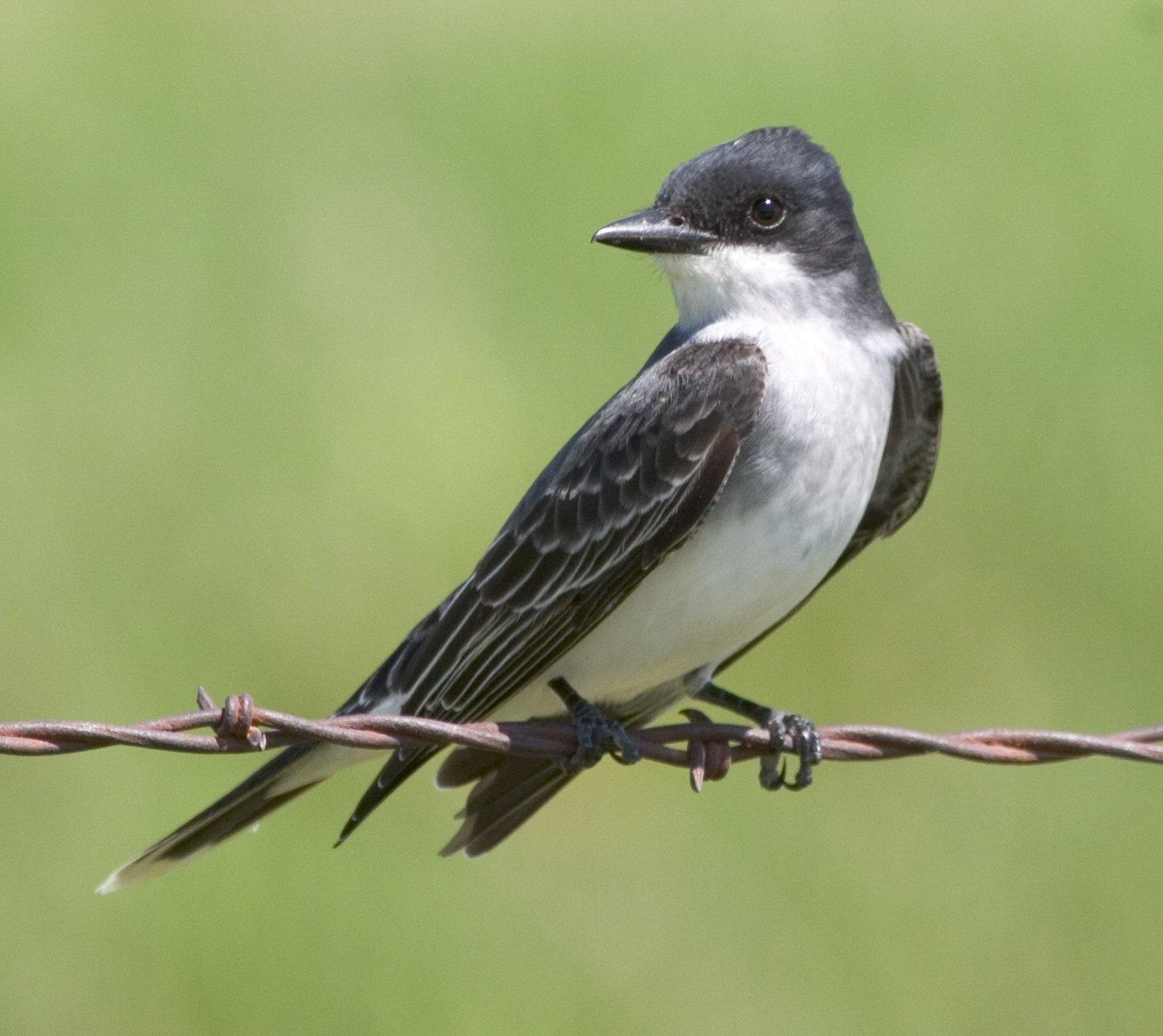Eastern kingbird
(Tyrannus tyrannus)

Description
The Eastern Kingbird (Tyrannus tyrannus) is a migratory passerine bird that belongs to the tyrant flycatcher family. These birds are well-known for their aggressive behavior towards predators, and for their impressive aerial acrobatics. In this article, we will explore the different aspects of the Eastern Kingbird's physical characteristics, distribution, habitat, behavior, diet, reproduction, and conservation status. Physical Characteristics: The Eastern Kingbird (Tyrannus tyrannus) measures around 20-23 cm in length and has a wingspan of 36-40 cm. They have a blackish-blue cap, dark gray upperparts, and a white underbelly. Males and females have similar plumage, but males tend to have a slightly larger black cap. They also have a distinctive white band at the tip of their tail. Juvenile birds have brownish-black upperparts, and the white band on their tail is less noticeable. Overall, they have a sleek and slender body, with a sharp, hooked beak that is well-suited for catching insects in mid-air. Distribution and Habitat: The Eastern Kingbird has a wide distribution across North and South America. During the breeding season, they can be found in the northern regions of North America, including Alaska and Canada, and as far south as northern South America. During the winter months, they migrate to Central and South America. The Eastern Kingbird can be found in a variety of habitats, including open woodlands, grasslands, and wetlands. They prefer open areas with scattered trees and shrubs, and are often found near water sources. They are also known to be adaptable and can be found in urban and suburban areas, such as parks and gardens, especially during migration. However, they are less common in heavily forested areas. Behavior: The Eastern Kingbird is an aggressive and territorial bird, known for its bold behavior. They are fiercely protective of their nesting territories and will aggressively defend them against any potential threats, including predators, other birds, and even humans. They are also known for their impressive aerial acrobatics, which they use to catch flying insects. During the breeding season, Eastern Kingbirds form monogamous pairs. They build their nests in trees or shrubs, and both parents take part in incubating the eggs and feeding the chicks. Eastern Kingbirds are known to be highly protective of their young and will aggressively defend their nest against potential predators. They communicate with each other through vocalizations and body language, including wing flicking and tail spreading. Eastern Kingbirds are migratory birds and travel long distances during their annual migration. They usually migrate in large flocks and are known to roost together in trees at night. During migration, they may be seen feeding on fruits and berries in addition to insects. Overall, the Eastern Kingbird is an active and social bird, often seen perching on high points and calling out to other birds in their territory. Diet: The Eastern Kingbird is an insectivore, meaning that it primarily feeds on insects. They are known for their aerial hunting skills and catch their prey in mid-air using their sharp, hooked beaks. Their diet consists of a wide variety of flying insects, including flies, wasps, beetles, grasshoppers, and dragonflies. They are also known to occasionally feed on spiders and small fruits during migration. Eastern Kingbirds are highly territorial birds and will defend their feeding territories against other birds. They are also known to engage in a behavior called "hawking," where they fly out from a perch to catch an insect in mid-air, and then return to the perch to eat it. This behavior allows them to conserve energy while still capturing their prey. Overall, the Eastern Kingbird is an important predator of flying insects and plays a vital role in regulating insect populations in their habitats. Reproduction: Eastern Kingbirds breed during the summer months, and both males and females take part in nest building, incubation, and chick rearing. The nest is built in a tree or shrub, and is made of twigs, grass, and other plant materials. The female typically lays 2-5 eggs, and both parents take turns incubating the eggs for around 14 days. The chicks hatch altricial, meaning they are born blind and naked, and are completely dependent on their parents for food and protection. The chicks fledge after around 14-18 days and become independent after around a month. Conservation Status: The Eastern Kingbird is currently listed as a species of "Least Concern" by the International Union for Conservation of Nature (IUCN). This means that they are not considered to be in danger of extinction at the global level. However, there are some local threats to their populations. Loss of habitat due to land development and agricultural practices can impact their breeding success. Pesticide use can also have negative effects on their populations by reducing their insect prey. Conservation efforts aimed at protecting and restoring their habitats can help ensure the continued success of Eastern Kingbird populations. This can include preserving and creating open habitats with scattered trees and shrubs, as well as minimizing the use of pesticides in areas where they are known to breed. Additionally, citizen science efforts, such as monitoring their populations and reporting sightings, can help researchers better understand their distribution and population trends. Conclusion: In summary, the Eastern Kingbird is a migratory passerine bird that is known for its aggressive behavior, impressive aerial acrobatics, and distinctive plumage. They are found across a wide geographic range in North and South America and can be found in a variety of habitats. Their diet consists mainly of flying insects, and they breed during the summer months, building nests in trees or shrubs. While their populations appear to be stable, habitat loss and fragmentation could pose a threat to their populations in the future.
Taxonomic tree:







